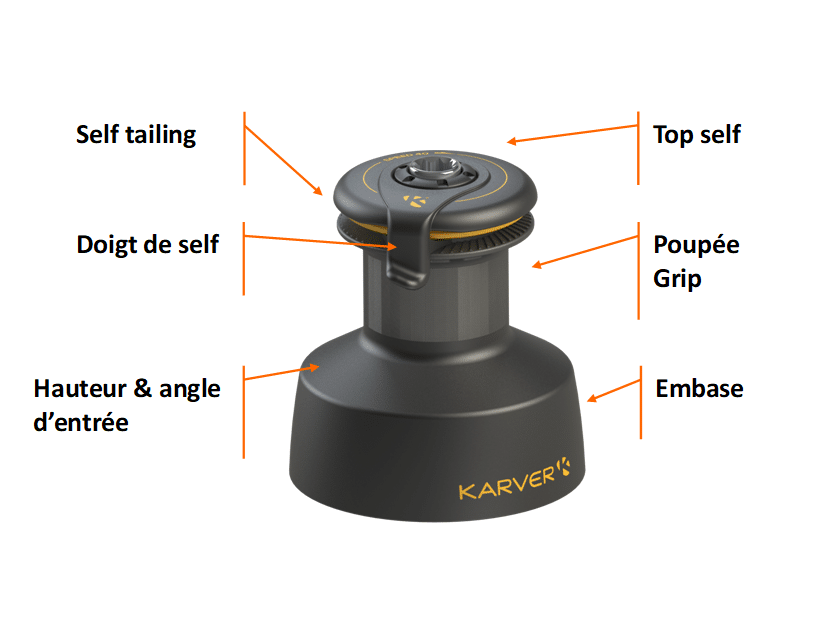Choosing your winch : The element of understanding
Originally – Technical specifications – The winch according to Karver
ORIGINALLY…
Raise the anchor, hoist the sails, adjust them,… as the size of the boats increases, it becomes impossible to pull or hold the ropes by hand. The significant efforts on sailboats forced sailors to find technical solutions to pull loads that exceeded their own strength.
Since antiquity, until today, many techniques have been used (capstan, winch, etc.), to finally arrive today at the generalized use of modern winches.
The main winch manufacturers are : Harken, Lewmar, Andersen (Ronstan), Antal, Selden, Karver, Barton, …
N ORDER TO COMPARE THE WINCHES WITH ONE ANOTHER AND IN ORDER TO KNOW WHICH ONE WILL BEST SUIT YOUR NEEDS, YOU SHOULD BETTER UNDERSTAND THE TECHNICAL CHARACTERISTICS DISPLAYED BY THE MANUFACTURERS :
- Self tailling : Device invented in the 1970s, which allows to capture the rope in a system of jaws and to use the winch with one hand for the handle.
- Drum : Cylinder which constitutes the external body of the winch on which the rope is furled and which will receive a handle in its upper part.
- The grip is the surface condition of the drum which can be from smooth to very aggressive.
- Maximum working load (MWL) : each winch must be able to withstand the loads present. Shipyards and yacht designers define these values. In the event of a winch replacement, you will find this information in the documentation for your current winch.
- Power ratio : represents the tensile force generated by the winch for 1 kg of force applied to a standard handle (254 mm). It generally defines the size of the winch : a size 40 = 40 kg of traction for 1 kg in the handle (1: 40). The larger this number, the less force you will have to use on the handle. Thus a 40ST2A is a winch of max power 1:40 equipped with a self tailing (ST), with 2 speeds (2) and equipped with an aluminum drum (A)
- Gear ratio : defined the number of handle turns to be given to make 1 complete turn of the drum. Conversely, and depending on the diameter of the drum, this ratio will make it possible to define the length of strope engaged at each turn of the handle. Example : 6.28: 1 = 6.28 turns of the handle for one turn of the drum. A ratio less than 1 means that one turn of the handle turns the drum several times.
- Rope entry height & angle : The height is used to define the angle which should generally be between 5 and 8°. Respecting this angle guarantees correct operation and more particularly for fast winches.
- Output length (or speed) : this is more concrete than the speed ratio since it is the length of the rope engaged for one turn of the handle. This data is very rarely provided and it must therefore be calculated : speed ratio x µ (3.14) x Drum diameter.
- Dimensions : compare winches of equivalent sizes (in addition to the load capacity). The reference values are generally the diameters of the base and the drum as well as the total height of the winch
- Weight : argument more sensitive for the racers than for the pleasure boaters. It is to be put in the light of the performances obtained.
- Number of speeds : 95% of winches have 1 or 2 speeds. Like a car, a winch can have several possible gear ratios. The speed change is effected by reversing the direction of rotation of the handle. The 3rd gear sometimes offered by some manufacturers is engaged by activating a mechanism except at Karver where the change to 3rd and 4th gear continues to take place with a simple change of direction of the handle.
- Electric winch : Replacement of the handle by a gear motor and a motor under the winch, for operation, by button. For larger units (usually around 60-80 feet) the motor may be hydraulic and hooked up to a hydraulic power plant.
- Coffee grinders : Used mainly on racing boats, this double handle system mounted on a column allows the use of manual gearboxes, by a transmission system by tubes and return boxes.
- Materials : the drum can be in aluminum (A), in chrome-plated bronze (C), in stainless steel,… Aluminum drums are the most common and the lightest.
- Price : an important criteria for most sailors but which must be put in relation with the technical elements above.

THE WINCH ACCORDING TO KARVER
Although visually our winches look like any other, our KSW and KPW winches are equipped with 4 automatic speeds. This major innovation, unique on the market, keeps 2 speeds comparable in all respects with other winches on the market but also offers 2 additional speeds.
The 2 additional speeds of KSW (Speed) winches are devoted to speed and will therefore most often interest sailors (6 times faster than a winch of the same size).
The 2 additional speeds of KPW (Power) winches make it possible to divide the effort by 3 and are usually more attractive to boaters.
Regarding our KPW Compact winch. It retains the traditional 2 speeds but we have chosen to offer a faster 1st speed and a smoother second speed.
To find out more, visit thewinch pagesof our website.
Tanguy de LARMINAT – Update : April 2021







